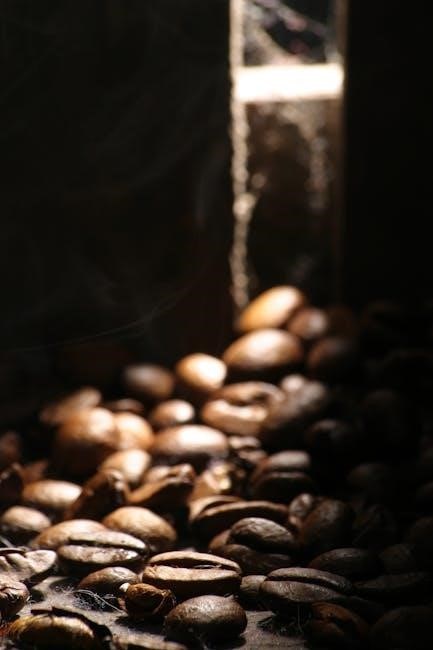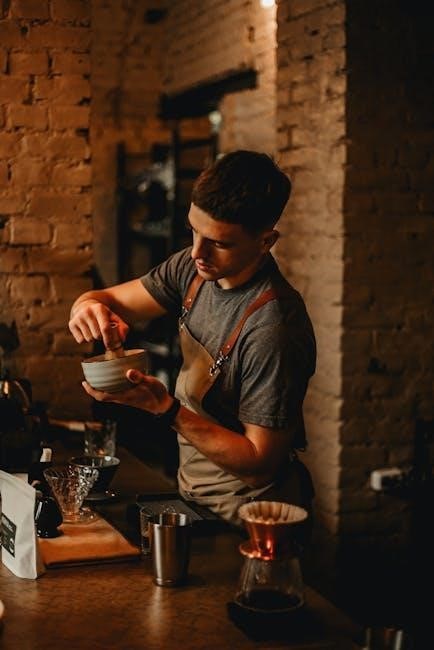Grinding your own coffee beans is a fundamental step in brewing the perfect cup․ It enhances flavor‚ aroma‚ and quality‚ transforming your coffee experience․ Learn the basics of grinding to elevate your brew․
Types of Coffee Grinders
Coffee grinders come in two main types: blade grinders and burr grinders․ Blade grinders are affordable but produce uneven grinds‚ while burr grinders offer precise‚ consistent results‚ making them the choice for coffee enthusiasts․
2․1 Blade Grinders
Blade grinders are the most common and affordable type of coffee grinder․ They use a spinning blade to chop the beans into smaller pieces‚ creating a grind․ While they are easy to use and inexpensive‚ blade grinders have some drawbacks․ The spinning blade can generate heat‚ which may damage the beans and lead to a loss of flavor․ Additionally‚ blade grinders often produce an inconsistent grind‚ with some particles being finer than others․ This inconsistency can result in uneven extraction during brewing‚ affecting the taste of your coffee․ Blade grinders are best suited for casual coffee drinkers who prioritize convenience over precision․ For those seeking a high-quality grind‚ blade grinders are not the ideal choice․ However‚ they remain a popular option for their accessibility and simplicity․ If you do use a blade grinder‚ it’s recommended to pulse the grinder and check the consistency regularly to achieve the best results․
2․2 Burr Grinders
Burr grinders are the preferred choice for coffee enthusiasts and professionals alike․ Unlike blade grinders‚ burr grinders crush the beans between two abrasive surfaces‚ resulting in a consistent grind size․ This method generates less heat‚ preserving the coffee’s delicate flavors and aromas․ Burr grinders are available in two main types: conical and flat burrs․ Conical burrs are more common in home grinders and are known for their durability and ease of use․ Flat burrs‚ often found in commercial settings‚ offer precise control over grind size but may require more maintenance․ One of the key advantages of burr grinders is their ability to produce a uniform grind‚ which is essential for optimal extraction during brewing․ While they are generally more expensive than blade grinders‚ the investment pays off in terms of flavor quality․ Regular cleaning is recommended to ensure optimal performance and prevent any residual coffee oils from affecting future brews․ Burr grinders are a worthwhile investment for anyone serious about achieving the perfect cup of coffee․

The Coffee Grinding Process
The coffee grinding process involves measuring the beans‚ adjusting the grinder‚ and grinding to the desired consistency․ Proper grinding enhances extraction‚ aroma‚ and overall flavor quality in your brew․
3․1 Measuring the Right Amount
Measuring the right amount of coffee beans is crucial for achieving the perfect brew․ A general rule of thumb is to use 1 to 2 tablespoons of beans for every 6 ounces of water․ This ratio ensures balanced extraction and flavor․ Adjust the quantity based on personal taste preferences‚ but consistency is key․ Too little coffee may result in a weak brew‚ while too much can make it bitter․ Use a digital scale for precision‚ especially when experimenting with different brewing methods․ Freshly roasted beans are denser‚ so you may need to adjust the volume accordingly․ Proper measurement sets the foundation for an optimal grinding process‚ ensuring each cup is tailored to your liking․ Start with this guideline and fine-tune as you explore various roasts and brewing techniques․
3․2 Adjusting the Grinder
Adjusting the grinder is a critical step in achieving the perfect grind size for your brewing method․ Start by selecting the right grinder type—burr grinders are preferred for their consistency․ Blade grinders‚ while affordable‚ often produce uneven results․ For burr grinders‚ begin with a medium setting and dial it in based on the desired grind size․ If the grind is too fine‚ it may lead to over-extraction‚ while a coarse grind can result in under-extraction․ Grind in small batches to avoid overheating the beans‚ which can damage the grinder and affect flavor․ After grinding‚ inspect the consistency and adjust the settings as needed․ Clean the grinder regularly to remove residual coffee oils and prevent stale flavors․ Proper adjustment ensures a balanced extraction‚ elevating the quality of your brew․ Experiment with settings to find the ideal grind for your favorite brewing method‚ whether it’s espresso‚ pour-over‚ or French press․
Coffee Grind Sizes for Different Brewing Methods
Coffee grind size significantly impacts flavor extraction․ Coarse grinds are ideal for French press and cold brew‚ medium for drip and pour-over‚ and fine for espresso․ Each method requires precise sizing for optimal results․
4․1 Coarse‚ Medium‚ and Fine Grind
Understanding the differences between coarse‚ medium‚ and fine grinds is essential for achieving the perfect brew․ A coarse grind‚ with its larger particles‚ is best suited for methods like French press or cold brew‚ where longer extraction times are needed․ This allows the bold flavors to develop without becoming bitter․ A medium grind is ideal for drip coffee makers and pour-over methods‚ as it provides a balanced extraction․ The particles are small enough to release sufficient flavor but not so fine that they lead to over-extraction․ For espresso‚ a fine grind is necessary to ensure proper pressure and rich flavor during the short brewing process․ Matching the grind size to the brewing method ensures a well-balanced and delicious cup of coffee every time․

Tips for Perfect Coffee Grinding
Use high-quality beans‚ grind just before brewing‚ and experiment with sizes․ Clean your grinder regularly and store beans properly to preserve flavor and aroma for the best results․
5․1 Use High-Quality Beans
Using high-quality coffee beans is essential for a superior brewing experience․ Freshly roasted beans retain their vibrant flavors and aromas‚ which are crucial for a perfect grind․ Opt for beans that are free from defects and have been properly stored to maintain their freshness․ The origin‚ roast level‚ and processing method of the beans also play a significant role in the final taste․ For instance‚ Ethiopian beans may offer fruity notes‚ while Brazilian beans provide a smoother‚ nuttier flavor․ Investing in premium beans ensures that your grinding efforts yield the best possible results․ Additionally‚ avoid pre-ground coffee‚ as it loses its flavor quickly․ By selecting top-tier beans‚ you lay the foundation for a truly exceptional cup of coffee․
Common Mistakes to Avoid
Avoid using the wrong grind size‚ grinding too many beans at once‚ and neglecting to clean your grinder regularly․ These mistakes can lead to inconsistent flavors and a less enjoyable brewing experience․
6․1 Wrong Grind Size‚ Too Much‚ Not Cleaning
Using the wrong grind size is a common mistake that can lead to over-extraction or under-extraction‚ resulting in a bitter or weak cup․ Grinding too many beans at once can cause uneven results and waste․ Neglecting to clean your grinder regularly allows old coffee oils and residue to accumulate‚ which can impart stale flavors to your brew․ To avoid these issues‚ always match your grind size to your brewing method‚ grind only what you need‚ and clean your grinder frequently․ Proper maintenance ensures optimal performance and flavor consistency․ By addressing these mistakes‚ you can elevate your coffee game and enjoy a perfect cup every time․

Maintaining Your Coffee Grinder
Regularly cleaning your grinder prevents old coffee oils from affecting flavor․ Check for worn parts and store it in a dry place to ensure optimal performance and longevity․
7․1 Cleaning the Grinder

Cleaning your coffee grinder is essential to maintain its performance and prevent flavor contamination․ Old coffee oils and residue can linger‚ affecting the taste of your brew․ Start by unplugging the grinder for safety․ For blade grinders‚ grind a small amount of rice to absorb oils and residue‚ then wipe clean with a dry cloth․ Burr grinders require a soft brush to remove grounds from the burrs․ Avoid using water‚ as it can damage the grinder․ Regular cleaning ensures optimal flavor and extends the grinder’s lifespan․ Consistency is key to preserving the quality of your coffee․
Mastering the art of coffee grinding is a journey that enhances every sip․ By choosing the right grinder‚ understanding grind sizes‚ and following proper techniques‚ you can unlock the full potential of your coffee beans․ Regular maintenance and attention to detail ensure consistency and flavor․ Whether you’re a novice or an enthusiast‚ the pursuit of perfect grinding is a rewarding endeavor that elevates your coffee experience․ Experiment‚ learn‚ and savor the difference that freshly ground beans make in every cup․
